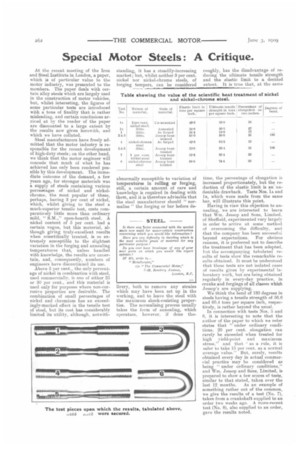Special Motor Steels : A Critique.
Page 14

If you've noticed an error in this article please click here to report it so we can fix it.
At the recent meeting of the Iron and Steel Institute in London, a paper, which is of particular value to the motor industry, was presented to the members. The paper deals with certain alloy steels which are largely used in the construction of motor vehicles, but, whilst interesting, the figures of some particular tests are introduced with a tone of finality that is rather misleading, and certain conclusions arrived at by the reader of the paper are discounted to a large extent by the results now given herewith, and which we have collated.
Steel manufacturers have freely admitted that the motor industry is responsible for the recent development of high-duty steels ; on the other hand, we think that the motor engineer will concede that much of what he has achieved has only been rendered possible by this development. The immediate outcome of the demand, a few years ago, for stronger materials was a supply of steels containing various percentages of nickel and nickelchrome, the most popular of these, perhaps, having 3 per cent of nickel, which, whilst giving to the steel a much-superior tensile test, costs comparatively little more than ordinary mild, " S.M.," open-hearth steel. A nickel content of 5 per cent. had a certain vogue, but this material, although giving truly-excellent results when scientifically treated, is so extremely susceptible to the slightest variation in the forging and annealing temperatures that, unless handled with knowledge, the results are uncertain, and, consequently, numbers of engineers have discontinued its use.
Above 5 per cent., the only percent, age of nickel in combination with steel, used commercially, is one of either 25 or 30 per cent., and this material is used only for purposes where non-corrosive properties are desirable. The combination of small percentages of nickel and chromium has an exceedingly-marked effect in the tensile test of steel, but its cost has considerably limited its utility, although, notwith
standing, it has a steadily-increasing market; but, whilst neither 3 per cent. nickel nor nickel-chrome steels, of forging tempers, can be considered
abnormally susceptible to variation of temperatures in rolling or forging, still, a certain amount of care and knowledge is required in dealing with them, and it is therefore advisable that the steel manufacturer should " normalise" the forging or bar before de, livery, both to remove any strains which may have been set up in the working, and to leave the steel with the maximum shock-resisting properties. The normalising process usually takes the form of annealing, which operation, however, if done the roughly, has the disadvantage of reducing the ultimate tensile strength and the elastic limit to a decided extent. It is true that, at the same time, the percentage of elongation is increased proportionately, but the reduction of the elastic limit is an-undeniable drawback. Tests Nos. Is and la, which were made from the same bar, will illustrate this point.
Having in view this objection to annealing, we are interested to learn that Wm. Jessop and Sons, Limited. of Sheffield, experimented very largely in order to arrive at some method of overcoming the difficulty, arid that the company has been succesaful beyond expectations. For obvious reasons, it is preferred not to describe the treatment that has been adopted, but the accompanying tabulated results of tests show the remarkable results obtained. It must be understood that these tests are not isolated cases of results given by experimental laboratory work, but are being obtained regularly in every-day practice, in cranks and forgings of all classes which Jessop's are supplying.
We think the bend of 180 degrees in steels having a tensile strength of 56.6 and 60.4 tons per square inch, respectively, is rather beyond the usual. In connection with tests Nos. 5 and 6, it is interesting to note -that the author of the paper to which we refer states that " under ordinary conditions, 20 per cent. elongation can rarely be exceeded when treated for high yield-point and maximum stress," and that " as a rule, it is safer to take 15 per cent, as a normal average value." But, surely, results obtained every day in actual commercial practice may be considered as being " under ordinary conditions," and Wm. Jessop and Sons, Limited, is prepared to show a few scores of tests, similar to that stated, taken over the last 12 months. As an example of something rather out of the common, we give the results of a test (No. 7), taken from a crankshaft supplied to an order two weeks ago. A more-recent test (No. 8), also supplied to an order, gave the results noted.




















